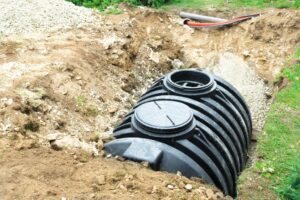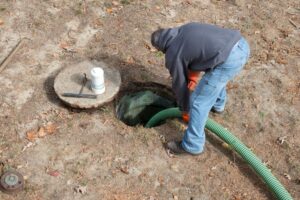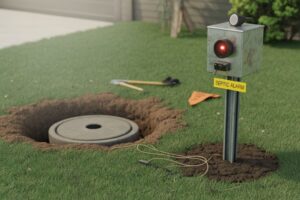Proper septic system installation starts beneath the surface—literally. A percolation test, often called a “perc test,” is the definitive way to ensure your soil can effectively treat and disperse wastewater. Not just another box to check, it’s an important step in protecting public health, avoiding environmental hazards, and ensuring long-term performance, and our experts at Gateway Septic Service know this well.
In this blog post, we’ll explore why percolation testing for septic tanks is more than just a regulatory requirement. You’ll learn what a percolation test involves, how soil impacts your system’s success, what to do if your land doesn’t pass, and how test results shape your system design. We’ll also discuss the optimal time for testing, the implications of the results for homeowners across Skagit County, including Oak Harbor, Mount Vernon, Stanwood, Sedro-Woolley, Burlington, and surrounding areas, how to select the most suitable solution based on your site conditions, and why septic tank pumping, cleaning, and inspection services are essential to maintaining system efficiency.
Whether you’re building a new home or replacing an aging system, this guide will help you understand why a septic system soil test is the cornerstone of a healthy, cost-effective, and code-compliant septic system.
Let’s dig in.
What Is a Percolation Test?
A percolation test measures the rate at which soil absorbs water, determining whether the ground can handle septic effluent. The procedure is simple yet scientifically grounded:
- Excavate one or more test pits—typically 300 mm square and up to 1 m deep below the drainpipe invert level.
- Saturate the pit by adding water and allowing it to stabilize overnight.
- Measure drainage rate: refill the pit to ~300 mm depth, then monitor how long it takes to drop between 75% and 25% full.
- Calculate infiltration rate (Vp)—time divided by drop, averaged across multiple pits.
Even the leading septic tank inspection service experts in Oak Harbor reveal that health codes typically need values within a specific range (e.g., 15–100 seconds/mm) to deem the site healthy and acceptable.
The Role of Soil in Septic System Functionality
Your soil is more than dirt, but the lifeblood of your septic system. Its composition directly impacts:
How quickly effluent is absorbed (too fast = inadequate treatment; too slow = backups/flooding).
Sizing of your drain field—percolation results guide trench length and design.
Here’s how soil textures perform:
| Soil Type | Drainage Rate | Impact on Septic Design |
| Sandy / Loamy | Fast absorption | Smaller drain field, but ensure adequate treatment |
| Chalky | Moderate absorption | Ideal percolation zones |
| Clay / Silty | Slow to very slow | Larger field, increased risk of saturation |
These distinctions are important in Skagit County, where Gateway Septic operates, providing local septic tank pumping and repair expertise with soil that’s as varied as the communities of Oak Harbor, Burlington, Stanwood, Mount Vernon, and beyond.
How Percolation Tests Determine System Feasibility
A perc test for septic system installation reveals three possible outcomes:
- Soil drains too slowly (high Vp): the system may overflow or back up—poor absorption.
- Soil drains too quickly (low Vp): effluent might not be treated before percolating—pollution risk.
- “Goldilocks zone” soil absorption: just right, meaning standard systems can be used.
Only by quantifying the infiltration rate can you finalize:
- Whether the site passes the feasibility check.
- The size of the drain field is calculated using the formula: A = V × P × 0.20 (sewage) or ×0.25 (septic), where P represents the number of person-equivalents.
- Which type of septic system suits the site (e.g., conventional gravity vs. pressurized dosing systems)?
What Happens if Your Land Fails the Test?
Failing a perc test is more common than homeowners think—and it’s not a dead end. Here’s what follows:
Reevaluate system design:
According to the leading septic tank cleaning, inspection, and pumping service experts in Oak Harbor, alternative systems such as mound systems, holding tanks, or aerobic units may suit marginal soils, though they are costly.
Site relocation:
A different area on your property may yield better results.
Soil modification:
Adding sand or engineered media requires a permit and professional oversight.
Consult professionals:
That’s where Gateway Septic Service’s decades of local experience come in. Our septic tank pumping and repair service experts in Stanwood, Sedro Woolley, and nearby areas can help navigate approvals, redesign, and installation plans.
Without testing, you risk:
- Sewage backups
- Drain field failure
- Environmental contamination
- Legal violations with county health authorities
When and How to Conduct a Percolation Test?
Timing matters. Avoid perc tests during or immediately after:
- Heavy rain, drought, or frost.
Optimal times are:
- Spring or early fall, mid-season conditions.
- Multiple test pits: minimum two, ideally three to five, spread across the field.
Steps summary:
- Map proposed drain field layout.
- Dig test pits (300 mm × 300 mm × depth).
- Soak overnight.
- Conduct three soak-and-measure cycles.
- Average results → Compute Vp.
- Submit to county health; get approval.
For homeowners, this may seem daunting, but registered professionals like Gateway Septic Service handle site prep, testing, interpretation, and submission. We’re licensed for septic tank inspections, percolation testing for septic tanks, and full system design across Skagit County.
Percolation Test Results: What Do They Mean?
Results fall into clear categories:
| Vp Range (s/mm) | Soil Behavior | System Implications |
| <15 | Too rapid drainage | Effluent passes too quickly – poor treatment; consider mound/aerobic. |
| 15–60 | Ideal absorption | Standard drain field, effective treatment |
| 60–100 | Slow but acceptable | Larger drain field required |
| >100 | Too slow drainage | Risk of backups—needs alternative system design |
Interpretation:
- Fast-draining soils: risk contamination; often need advanced systems.
- Slow soils may require oversized fields or alternative setups.
- Borderline results → expert assessment.
Gateway Septic’s soil evaluation informs:
- Whether installation is feasible
- How large and deep the system must be
- Which system components (e.g., septic tank risers) are needed?
Choosing the Right Septic System Based on Soil Type
After passing a percolation test, you still have design options:
Conventional Gravity System
Ideal when soil is moderate (Vp 15–60 s/mm).
Our services include:
- Septic system installation
- Proper tank sizing
- Drain field layout
Pumped or Pressurized Systems
Used in slower soils. Small dosing pumps deliver effluent evenly to avoid saturation.
Mound Systems or Aerobic Units
For failed tests or poor soils.
Our septic tank inspection, pumping, and cleaning service experts in Burlington, Skagit, and surrounding locations provide consultation and referral for these systems within Skagit County regulations.
Alternative Media or Sand Filters
In specific cases where soil adjustment is allowed.
For all options, our firm offers:
- Detailed quotes
- Permit submission
- Full septic tank inspections, repairs, pumping, and ongoing maintenance.
Pro Tips
- Always call a licensed technician and don’t rely on assumptions.
- Keep excavation records for permitting.
- Get septic tank risers installed for easier access during the maintenance service.
- Label and map your drain field for future reference.
Gateway Septic’s Local Edge & Brand‑Expertise
We stand out because:
- 49+ years of septic tank repairs and pumping services in Burlington, Oak Harbor, Mount Vernon, Stanwood, Sedro‑Woolley, and Skagit County.
- Affordable, transparent pricing, with flexible payment plans.
- We respond quickly to emergencies, including frozen systems and routine septic pumping, cleaning, and maintenance services, all handled promptly.
- Deep familiarity with soil and regulations in those Northwest Washington communities.
Our approach is personal, professional, and community-rooted.
In Summary: Securing a Safe, Efficient Septic System
A perc test for a septic system is more than a permit requirement, but foundational for increasing the lifespan of your unit, environmental protection, and household safety. Knowing your soil’s absorption rate ensures you choose a system that’s just right, not too big, not too small.
With decades of regional experience, Gateway Septic Service excels at every stage of this journey:
- Soil test and interpretation
- Custom system design (gravity, pressurized, mound, aerobic)
- Excavation, installation, pumping, cleaning
- Repairs, inspections, and emergency response
- Transparent pricing and financing options
Final Thoughts
Your septic system is a hidden hero—until it isn’t. A properly performed percolation test is the unsung hero’s sidekick, securing that your system works reliably, safely, and quietly for decades. With Gateway Septic Service by your side, you gain more than technical know-how. You gain a partner rooted in community, committed to quality, and established by almost half a century of local septic tank inspection, pumping, cleaning, repair, and maintenance service in Oak Harbor, Mount Vernon, Stanwood, Sedro-Woolley, Burlington, Skagit, and nearby areas.






